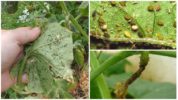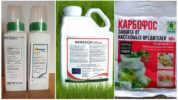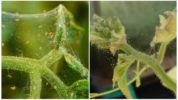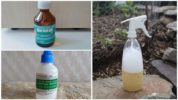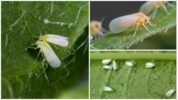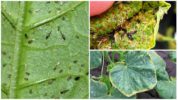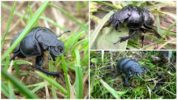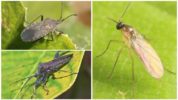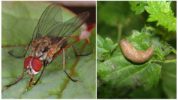- Pest No. 1 - Aphids
- Signs of aphid cucumber damage
- How to get rid of aphids
- Dangerous pest - spider mite
- What is the danger of a spider mite for cucumbers
- Ways to fight
- Whitefly is a nice looking pest
- Signs of whiteflies
- How to destroy a pest
- Black pests
- Thrips
- Strigun beetle
- Cucumber bug
- Cucumber mosquito
- Sprout fly
- Slug
- Gall nematode
- Rare, but no less dangerous pests of cucumbers
- Aphid
- Anti-aphid preparations
- Spider mite
- Spider mite control
- Whitefly
- Folk whitefly recipes
- Thrips
- Strigun beetle
- Cucumber bug and mosquito
- Sprout fly and slug
- Gall nematode on cucumbers
The history of growing cucumbers totals, according to some, about 4 thousand years, according to others - 2 millennia. Vegetable, classified by botanists as a false berry, was revered in ancient Rome, and in Russia, and in all European states. Many varieties have been bred by breeders, which makes it possible to cultivate plants in different climatic conditions and in different soils. However, pests of cucumbers often contribute to lower yields. Knowing what parasites look like, the peak of their activity and the harm done, it is possible to prevent their harmful activity and preserve the crop.
Pest No. 1 - Aphids
The most famous pests of cucumbers in the open ground are representatives of the large family of Real aphids. More than 1000 species are known, but more often than others the melon aphid is found - a polyphagous species that uses different crops as a food base.
On a note!
If small yellow insects are noticed on cucumbers - with a high degree of probability it can be argued that this aphid. Pests are also green and black-green with or without wings. Oval body sizes range from 1 to 1.9 mm. A thin long antennae are visible on the head.
Overwinter eggs, larvae and wingless virgins in the root foliage of weeds. As soon as the thermometer rises above 12 ° C, successfully overwintered individuals leave their shelters and begin to parasitize and form colonies. Thanks to the parthenogenetic method of reproduction, the population size is increasing rapidly.
Aphids settle on the underside of leaves, gradually spreading, into buds, inflorescences. They feed on plant juices, which leads to disruption of photosynthesis, wilting of the plant, reduced yield and even death of the crop. Photos of pests and cucumbers affected by them clearly show the activity of aphids.
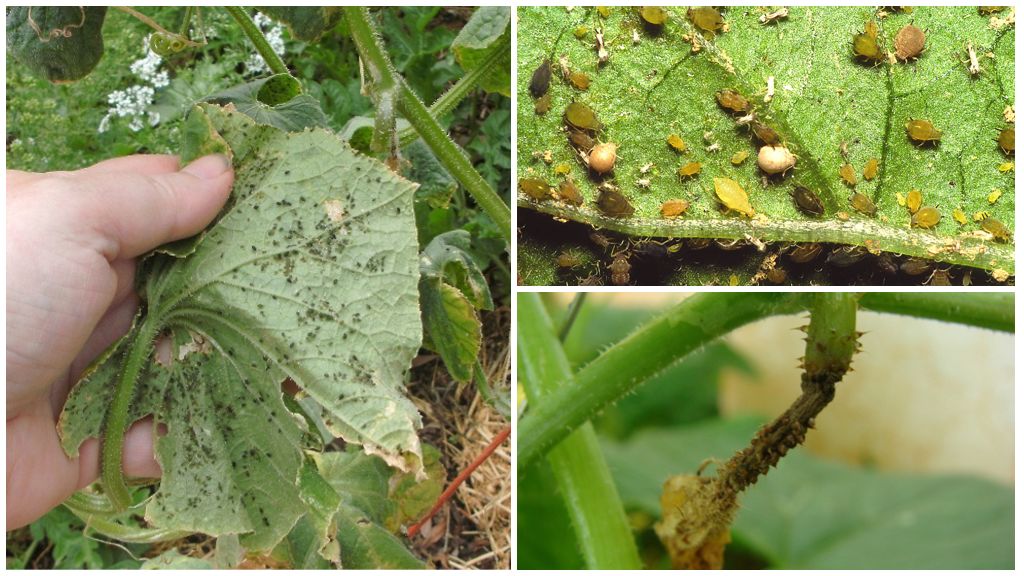
Signs of aphid cucumber damage
It is not difficult to identify that cucumbers are affected by aphids:
- On the reverse side of the leaves, numerous clusters of wingless and winged small midges of yellow, green color are noticeable. There may also be black insects on cucumbers - varieties of garden aphids, some gardeners call them cicadas.
- Sticky coating on the leaves - sweet insect secretions contribute to the development of soot fungus.
- Twisting, yellowing of leaf plates.
- Falling buds, stunted growth.
- The appearance of anthills on the site and ants scurrying along the cucumber stems and leaves.
How to get rid of aphids
You need to start fighting pests of cucumbers immediately after they are discovered. Strategy killing aphids depends on how badly affected the plants are, personal preferences in choosing a method.
Most Popular - folk remedies for aphids:
- Soap solution. 5 tbsp. l grated tar or laundry soap mixed with 5 liters of water. It is allowed to use liquid detergent at the rate of 1 tbsp. l per 100 g of water. Process the cucumbers with the resulting mixture, repeat the procedure after 2 days. Similarly, use a 1% solution of washing powder, in order to avoid leaf burns, it is recommended to test the product on one plant.
- Pour the chopped tomato tops (1 kg) with water (8-10 l) and insist for about 3 hours. To make the solution drip less, add 30-40 g of laundry or tar soap.
- You can get rid of insects by tobacco infusion. Components: 200 g of tobacco, 40 g of shavings of green or laundry soap pour 10 liters of hot water, leave for about a day, strain and spray the affected cucumbers.
- Mix 50 g of red or cayenne pepper with a liter of boiling water and let it brew for 2-3 hours. Add 9 l of water to the resulting solution and spray the affected aphid plants.
On a note!
Also recognized as favorites among folk remedies for aphids ash, vinegar, garlic, ammonia, milk with iodine, soda and even Coca Cola.
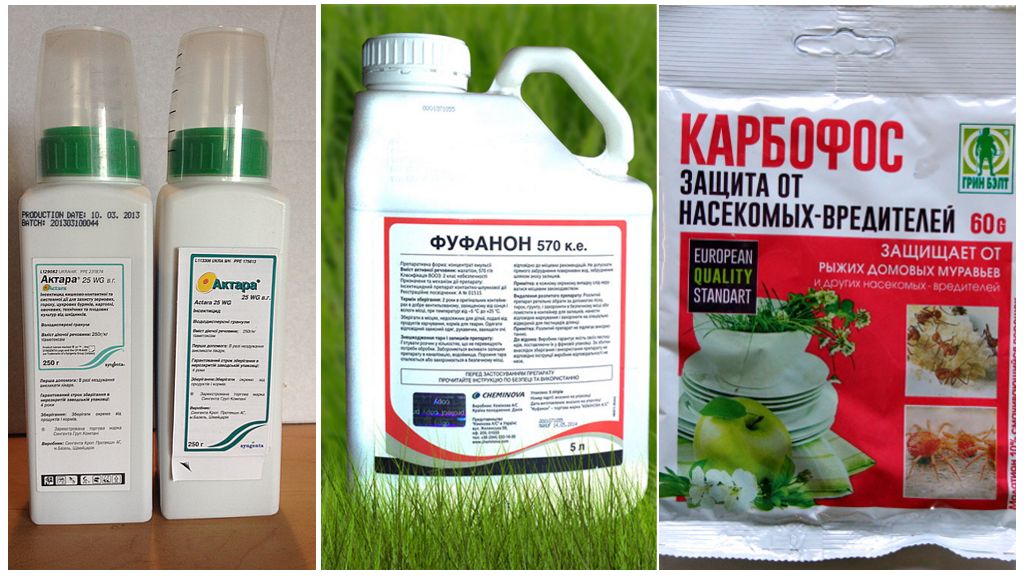
If you try to test folk recipes not in time, use Bole "heavy artillery":
- biological products Biotlin, Fitoverm, Arrow;
- Karbofos, Aktara;
- Spark, Tanrek, Fufanon.
The following measures will help to avoid the appearance of aphids on beds with cucumbers:
- Timely weed removal.
- Compliance with the planting schemes of cucumbers, the gap between plants must be at least 70 cm to ensure air access.
- In the aisles plant calendula, garlic, dill, parsley.
- Attract natural enemies of aphids: ladybugs, ghost flies. lacewing by planting umbrella crops.
- Enrichment of the soil with potassium.
- Regulation of the number of ants on the site.
On a note!
The benefits of ants in nature are invaluable. However, in gardens and garden plots, they can become a real disaster. Small workers are able to gnaw roots, shoots. Ants take care of aphids in order to get a sweet pad from them. Therefore, it is recommended to dig out the anthills and change the place of their localization, moving them away from their site. A less humane way - extermination of ants by folk remedies, drugs Anteater, Ant, gels.
Dangerous pest - spider mite
Despite the minimalism in size - the largest individuals barely reach 0.6 mm, this pest is not an insect, but belongs to arachnids. On the outside, the body is convex, covered with bristles. An adult tick has 8 limbs with sharp claws that allow it to hold firmly on cucumber stems. Color depends on living conditions and age. Six-legged larvae are transparent; as they grow older, they become light green, bottle-colored. The most striking appearance boasts females who are preparing for wintering. Their bodies are painted in red tones.
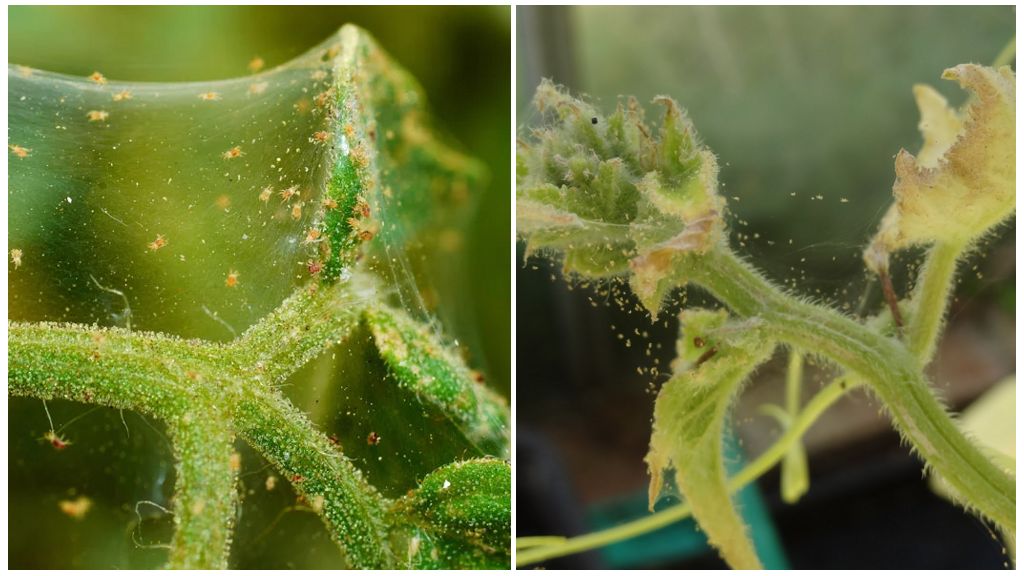
On a note!
Active breeding spider mites contributes to high temperature and low humidity. Greenhouses correspond to all these conditions, so often seedlings from greenhouses become the cause of pests in the open ground.
On cucumbers, the appearance of pests is observed in June-July. During this period, generations overlap each other, so you can see the tick at all stages of development: eggs, larvae, adults.
What is the danger of a spider mite for cucumbers
Both larvae and adults feed on plant juices, piercing a leaf plate from below, which is already harmful to plants. In addition, the spider mite is a carrier of gray rot spores.
Signs of damage to cucumbers with a spider mite:
- The presence of a web on cucumber lashes.
- Ticks pierce the bottom of the leaf plate and suck out chlorophyll. In places of punctures, the leaves are discolored. The injections may look like yellow or silver blotches.
- Numerous damaged fragments merge into a single unit, the sheet looks marbled, then brown and then dries.
- The culture lags behind in growth; large-scale damage can lead to the death of the plant.
Ways to fight
To get rid of pests, a set of measures will be required:
- Severely damaged leaves, shoots to remove and burn.
- The spider mite is afraid of moisture, so it is recommended to water in cloudy weather and cover with a film.
- The introduction of phosphate mineral fertilizers into the soil, which contribute to the growth of green mass and strengthen the resistance of plants.
- With minor damage to cucumbers, the use of folk remedies is allowed.
- With large-scale lesions, only biological products and chemicals can stop the invasion of the spider mite.
On a note!
Processing cucumbers is carried out in the evening. Given that the web protects arachnids, even when using the most powerful drug, about 50% of the pests die. Therefore, for a full result, 3-4 treatments are required. At a temperature of 20 ° C, cucumbers are treated every five days, if the temperature is higher than 30 ° C - processing is carried out with an interval of 3 days. This graph is due to the influence of temperatures on the appearance of larvae from eggs.
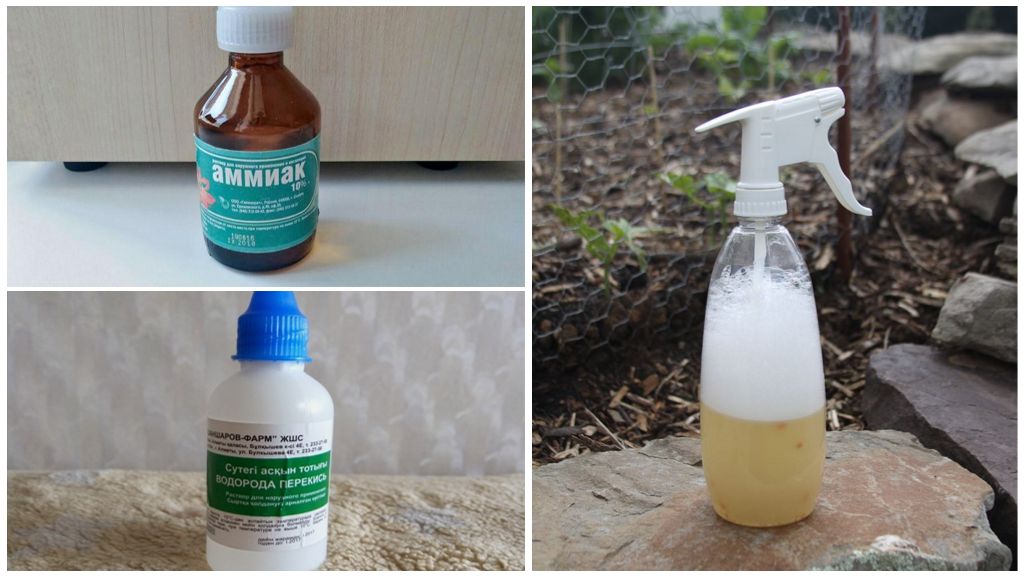
Effective folk remedies for spider mite:
- Powder the beds of cucumbers with tobacco dust or treat them with soapy water - these recipes will help get rid of pests at the initial stage.
- In a liter of water add tsp. ammonia, the resulting solution to process cucumber greens.
- Dilute in a liter of water 2 tbsp. l hydrogen peroxide 3% and spray cucumbers.
- Place beds with turpentine on the beds, temporarily cover the plants with cloth or film.
- 200 g of onion, garlic husks pour 10 liters of water, insist for a day, strain and process the planting of cucumbers.
- Grind 500 g of dandelion grass and pour 10 liters of water, let it brew for 3-4 hours, add a spoonful of liquid soap and the solution is ready for processing.
Shop preparations:
- Fufanon, Actellik - drugs with a wide spectrum of action, but are dangerous for bees, fish;
- Anti-tick - a means for single use, reprocessing will not bring results, as ticks develop resistance;
- Apollo, Omayt 57 - effective preparations for ticks, do not cause arachnids to get used to;
- Flumayt, Oberon, Floromayt;
- Biological products Vertimek, Kleschevit, Akarin, Agravertin, Actofit, Fitoverm.
On a note!
It is possible to reduce the risk of spider mites on cucumbers if cultivars resistant to the pest are used: Murashka F1, Benefis F1, Rodnichok.
Whitefly is a nice looking pest
A small butterfly with a yellow or yellowish-red torso and snow-white wings covered with powdery bloom. The size of the largest individual does not exceed 2 mm. Due to their miniature size, whiteflies are often called white midges.
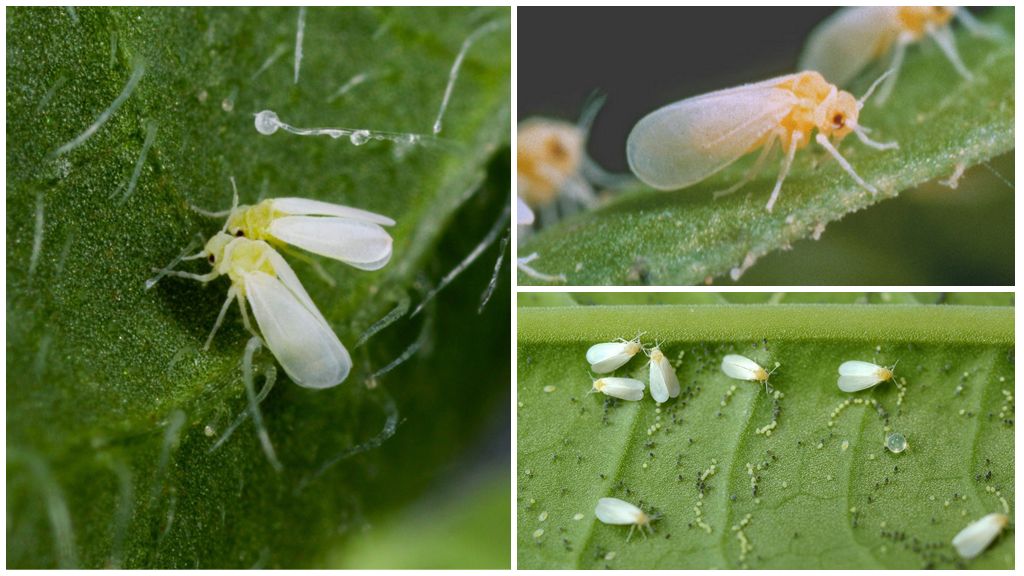
On a note!
Insects prefer high humidity and temperature from 22 ° C, so they are frequent residents of greenhouses. However, infected seedlings, appropriate temperature conditions and nearby greenhouses contribute to the resettlement of pests in beds with cucumbers in open ground.
Signs of whiteflies
The appearance of flocks of flying white midges should alert the grower. The following symptoms will help to accurately identify whiteflies:
- On the back of the leaf are numerous clusters of small white individuals, transparent yellowish larvae and tiny eggs. If you disturb the pests - adults will immediately fly up.
- The appearance of cloudy white drops on leafy plates is a sticky discharge of insects. They provoke the development of soot fungus, viruses.
- Mosaic placement of yellow, brown spots on the leaves.
- Twisting, yellowing of green mass, falling of ovaries.
- Deformation of young shoots.
Important!
If they didn’t take any measures, the culture would die, and the colony whiteflies will move to a nearby bush and continue its parasitic activity.
How to destroy a pest
Whiteflies often choose crowded landings, which create an air shortage. Therefore, it is necessary to strictly observe the scheme for planting cucumbers. If the pests have chosen a site, resort to mechanical, biological methods of control, the use of chemistry or folk remedies. The choice of method for protecting cucumbers from insects depends on the extent of the lesion and the area of plantings.
Mechanical methods of destruction:
- Grate a piece of laundry or tar soap, add shavings to a bucket of water, mix thoroughly. Rinse each sheet thoroughly with the resulting liquid. Alkaline solution will wash off not only pests, but also clean it from soot fungus.
- Using traps. The device is a sheet of bright yellow cardboard coated with an adhesive mass. Traps are placed near the beds with cucumbers and can significantly reduce the population.
On a note!
To attract ladybugs, who readily enjoy whiteflies, dill and chervil should be planted at the beginning of the season.
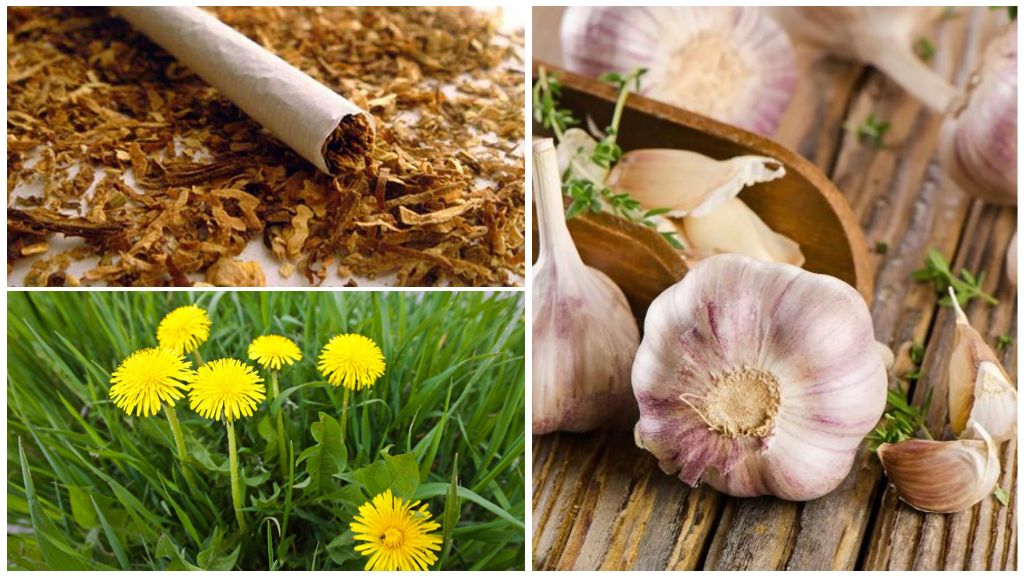
Of the folk remedies for the control of pests of cucumbers, the following have gained popularity:
- Finely chop 200 g of garlic, add 1 liter of water, leave for 5 days, strain. To prepare a working solution mix tsp garlic infusion with a liter of water.
- Grind 40 g of green parts of dandelion and 40 g of rhizomes, mix with a liter of water, stand for 3 hours and process the cucumbers.
- Combine and insist 80 g of yarrow and 1 liter of water for 2 days, strain, pour into a spray bottle and spray cucumber whips from whiteflies.
- Grind a pack of cheap cigarettes, pour hot water (1l). After 5 days, the solution is ready for use.
For mass occupation of whiteflies, store-bought preparations of Fufanon, Aktaru, Detis, Confidor, Permethrin, Pegasus are used.
Black pests
If black insects appeared on the beds with cucumbers, you should carefully consider their appearance and compare with the photo. Sometimes there is information that black fleas were noticed in cucumbers, they are also cruciferous. However, these insects harm crops corresponding to their names - cruciferous. In the gardens, cabbage often suffers from them.
Thrips
The size of insects is about 0.5 to 2 mm. A characteristic feature is a long elongated body equipped with running legs. About 300 species live in the post-Soviet space. Larvae of gray or light yellow color. The imago of a brown, gray, black color. More often thrips attack greenhouse cucumbers.
Important!
The first sign of thrips parasitism is the appearance of brown or colorless spots on young leaves that look like strokes. Gradually they merge into a single whole and this fragment dies, which leads to the appearance of holes. You can also notice silver lines on the leaves.
Combating pests of cucumbers is extremely difficult. Thrips lay eggs inside the leaf plate, the larva that appears only spends on the plant for some time, and leaves for soil to pupate. Of industrial means, Aktaru, Imidacloprid, Alatar, Avertin, Commander Maxi, Golden Spark.
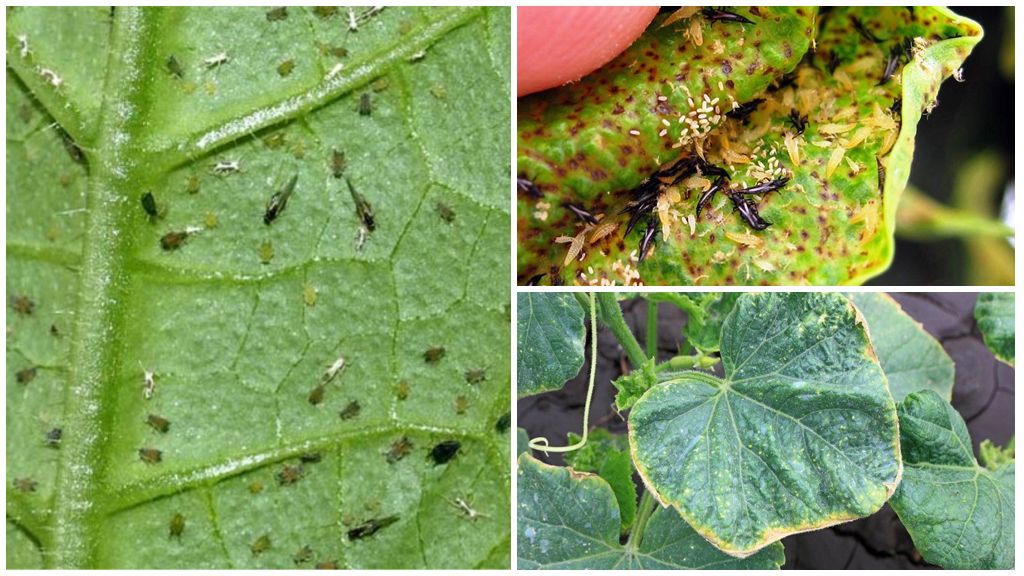
Folk recipes for the destruction of thrips:
- Processing with garlic, onion solution, which are also used from spider mites, aphids.
- 800 g of fresh celandine or 200 g of dry grass are mixed with 10 l of water. It is kept in a dark place for 1 to 24 hours. After which it is filtered through cheesecloth, liquid soap (100 g) is added and cucumbers are treated 3-4 times with an interval of 5-6 days.
- Use glue traps that help to significantly reduce the number of pests.
Disinfecting planting material and soil, removing weeds, and increasing the amount of watering will help reduce the risk of thrips in cucumbers.
Strigun beetle
Naturalists are touched by the photo of the pest and its lifestyle. However, for gardeners strigun beetle - a real disaster. He lives in underground burrows, where he builds passages and labyrinths. Beetle of black color, up to 3 cm in size, with a large head and powerful jaws. A herbivorous insect cuts grass and drags it into a hole. Harvesting is necessary for feeding offspring.
After wintering, they are selected to the surface at a temperature of 12 ° C. All plantings suffer from the insect. Black bugs on cucumbers cut leaves, young shoots. The main threat is for seedlings.
Pest control is complicated by its localization underground. Of folk remedies, gardeners recognized the most effective - a mixture of water (2l) and unrefined sunflower oil (100 ml). The liquid is poured directly into the burrows of pests. The oil film prevents air from entering the spiracles of the insect, which leads to its death. However, this approach does not make it possible to destroy the eggs and larvae of the strigun. Therefore, if there are too many beetles, Voloton is introduced into the soil during plowing.
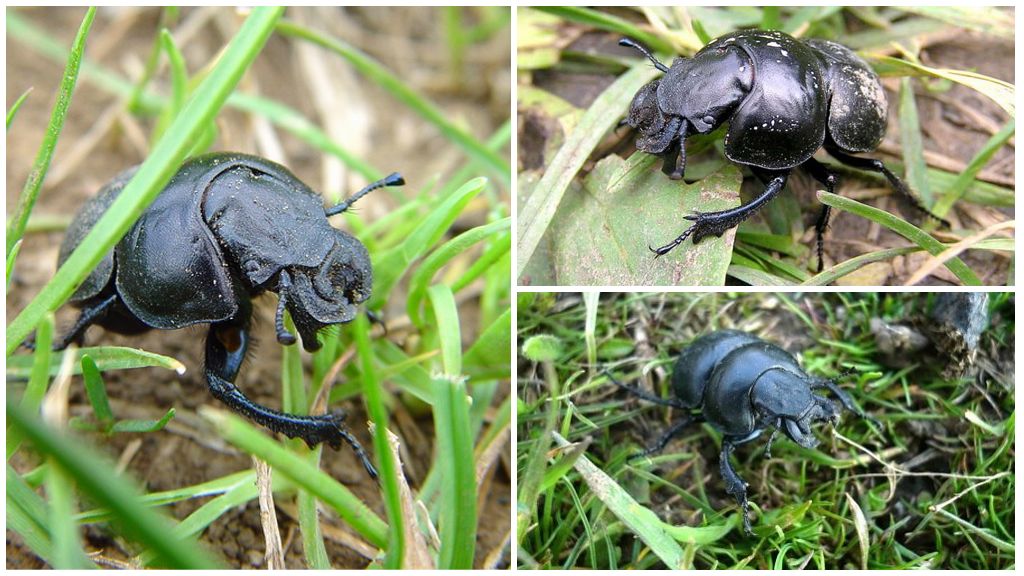
Cucumber bug
One of the smallest representatives of bug bugs. The size of an adult does not exceed 3 mm. The insect is black in color with well-developed limbs. It has excellent jumping ability. Often settles in greenhouses, in addition to cucumbers, it damages other crops. The presence of cucumber bugs give out twisted leaves. Oviposition is located in the stems.
Pest control involves the use of chemical and folk remedies:
- Processing garlic infusion.
- 400 g of crushed tobacco leaves + 10 l of water. After 2 days, add the same amount of liquid and process the cucumbers.
- Dilute 60 g of Karbofos in 10 liters of water, spray the affected cultures.
On a note!
A field bug can also harm cucumbers. Differs from cucumber in gray-green color. The harmfulness and control measures for both insects are identical.
Cucumber mosquito
An insect from the sciarid family. The body length is 3.5-4.5 mm. The color is gray, reddish shades, the head is black. The wings are transparent. Larvae are vermiform, up to 6 mm long, white, yellowish in color with a black head. The pest is thermophilic, therefore annoying cucumbers in greenhouses, greenhouses. The first generation appears in February-March. Mass years are celebrated in March-April.
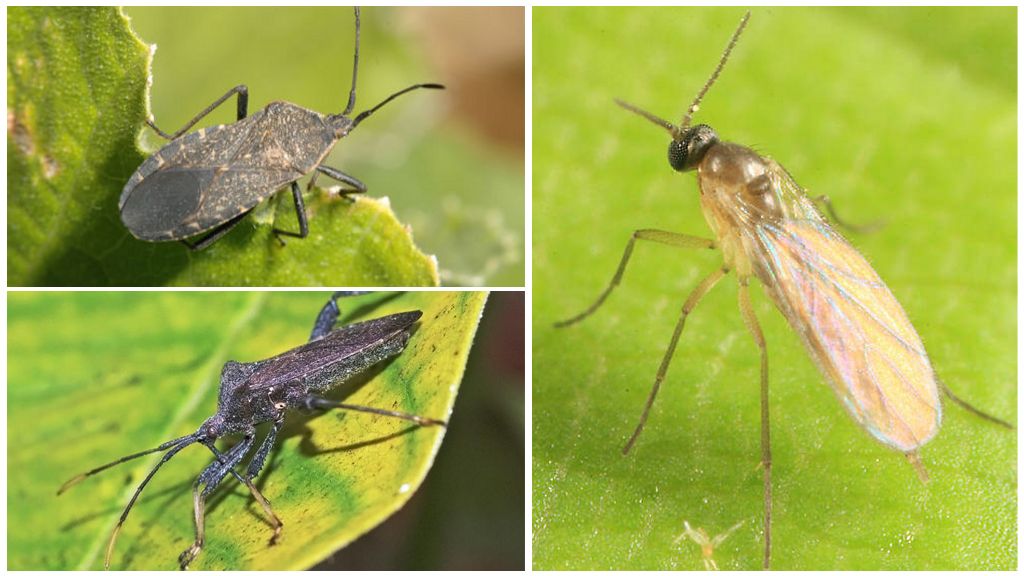
Important!
Larvae that drill holes in the root system and stems of plants are harmful. Cracks form on the affected culture, resulting in loss of turgor and wilting. With mass settlement - 50 larvae per plant, the process of decay begins. In addition to mechanical harm, cucumber mosquitoes infect cucumbers with viruses and harmful mites.
How to deal with small pests:
- Disinfection of the soil by thermal and chemical methods. Apply drugs Actellik, Spark, BI-58, Danadim.
- To get rid of adults, glue traps are hung up, Hypoaspis aculeifer ticks, entomopathogenic nematodes are hooked, greenhouse glasses are treated with Chlorophos or Thiophos.
Sprout fly
A very common pest of cucumbers in the open ground. The size of the fly is 3-5 mm. unprepossessing color: reddish torso with three dark longitudinal stripes densely covered with hairs, gray abdomen. A characteristic feature are the huge eyes. Years of pests begin in April and May. Flies immediately begin mating and laying white embossed eggs. After 3-7 days, transparent larvae appear that crawl into the cucumber stems, where they feed on plant juices.
Important!
The most dangerous are the larvae of the first generation of sprouting flies, since during their appearance the seedlings are still fragile and can die. Also, the larvae enjoy the cotyledons with pleasure, which is why the planted seeds of cucumbers do not sprout.
If pests have already been detected, cucumbers during the growing season must be treated with the preparations Funanon, Kemifos, Novaktion.To prevent the appearance of sprouting flies, deep plowing is carried out in autumn, burning of dry vegetation, in the spring, seed material is treated with the insecticide Spark, a solution of manganese. If the planting of cucumbers is carried out by means of seeds, it is recommended to use not dried, but germinated. Planting material is covered with a film.
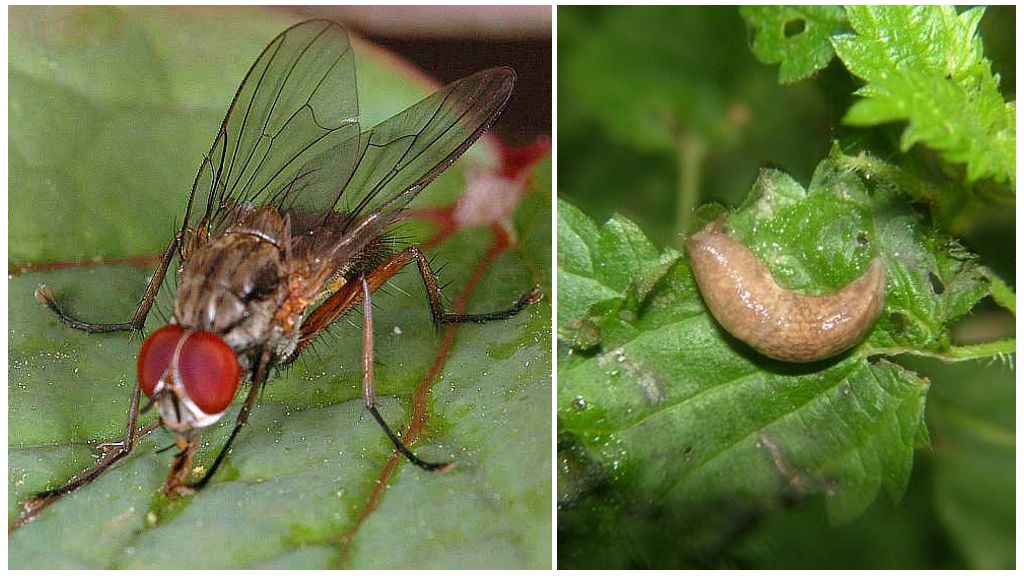
Slug
Slugs are active in the dark. Love moist and damp areas. The shoots and fruits of cucumbers suffer most from pests. After the invasion of slugs, holes and sticky traces remain, which in the light appear silvery.
How to protect cucumbers from slugs:
- To protect the planting of cucumbers from pests, create a barrier 10-15 cm wide. For this, needles, lime, ash, eggshell, dolomite flour, soda are used.
- Set traps. It is necessary to dig plastic bottles into the ground, having previously cut the neck. As a bait, use beer, syrup or jam. A simpler trap is a cabbage leaf, in the morning in which a large number of slugs will gather.
- Fight off pests by means of infusion of mustard, garlic or pepper.
- When there are still no ovaries on the cucumbers, it is allowed to fertilize ammonia after watering: 3 tbsp. l on 10 l of water.
- Along the perimeter, plant rosemary, garlic, parsley or sage.
- If there are too many slugs, use granular Meta and Thunderstorm products.
Gall nematode
A microscopic worm 1.5 mm long parasitizes mainly in closed ground. It lives in the soil, affects the root system. The pest is very fertile, each female is able to lay up to 800 eggs. The appearance of 12-13 generations is possible in a year.
Signs of damage are manifested in a lag in plant growth, yellowing and wilting of leaves, in a decrease in yield. At the roots, swellings are clearly visible. One of the reasons for the appearance of nematodes is the landing of cucumbers in the same soil for several years in a row.
Important!
Nematodosis reduces the yield of cucumbers by 50-60%.
How to get rid of worms pests:
- Plant legumes as traps. After 2-3 decades after the emergence of seedlings, they are pulled out and destroyed.
- Before planting cucumbers, treat the soil with boiling water.
- To combat nematodes, Fitoverm, Bi-58, Mearizine, Dimetoat are used.
- Sulfur checkers are used in greenhouses.
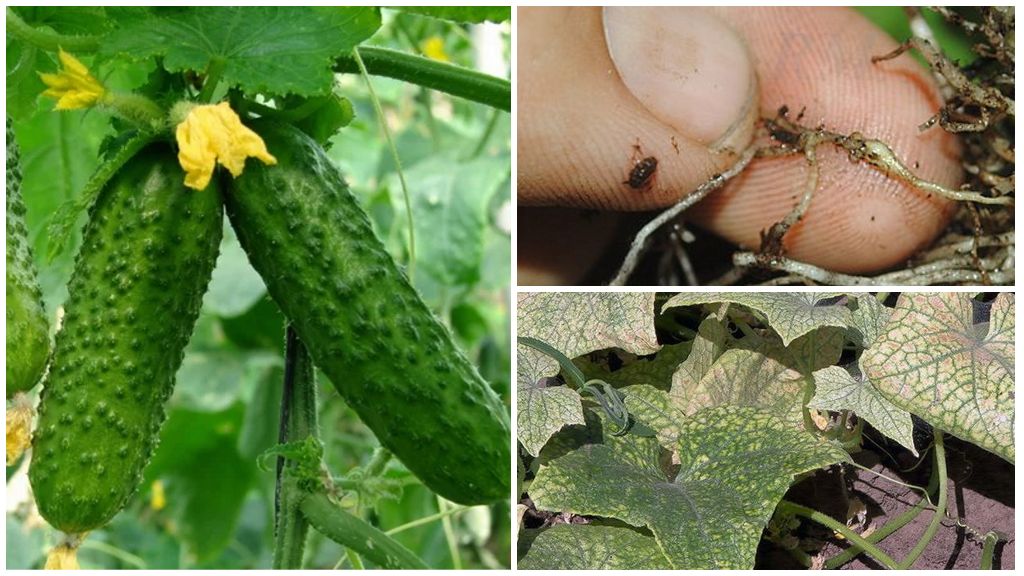
Rare, but no less dangerous pests of cucumbers
These pests are less likely to annoy gardeners, but this does not reduce their harmfulness:
- Cucumber beetle is widespread overseas; it is rare in European latitudes. Insects with bright yellow, green backs with longitudinal stripes. Larvae actively feed on plant tissues; adults damage buds. Cucumber beetles carry a disease from which it is impossible to save the plant. There are few ways to combat pest. You can reduce the number of individuals with manual collection or with sticky traps.
- Wireworm. Nutcracker larvae prefer acidic soils. Damage the roots of cucumbers, make their way into the stems. Protection from insects comes to the manual collection, liming and mineralization of the soil, planting legumes. In case of mass damage, use Calypso, Diazinon, Bazudin.
- Maybug Larvae deliver no less trouble. They are thick white caterpillars with a dark head. These are soil pests, therefore roots damage to cucumbers. To combat them, ammonia, onion infusion, manganese solution are used. As a preventive measure, the soil is mulched with wood sawdust, which prevents the females of the beetle in masonry.
- Medvedka. Seedlings are most harmful. It feeds on roots, root stems. Traps help reduce pests. When planting cucumbers, eggshells are used, a peeled clove of garlic is instilled, and chicken litter is fed.
- Caterpillars scoops brown color with a characteristic pattern, length 3-5 cm. Enjoy the underground parts of plants. To destroy the voracious, well-fed caterpillars, infusion of wormwood, preparations of Pochin, Bazudin, Agrovertin, Fitoverm are used.
- Woodlice are frequent pests in greenhouses. They live only at high humidity, they do harm by eating young shoots of cucumbers. For trapping, traps are used, boric acid is scattered, destroyed by means of Thunder-2, Aktar.
